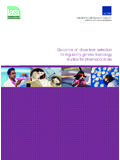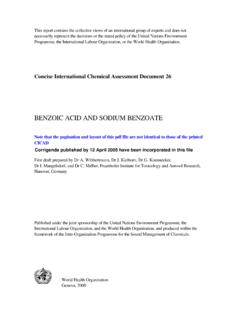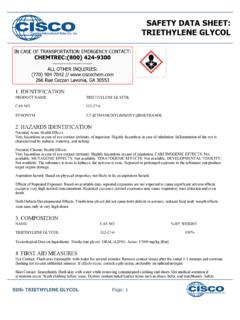Transcription of DRAFT OECD GUIDELINE FOR THE TESTING OF …
1 DRAFT OECD GUIDELINE FOR THE TESTING OF CHEMICALS. Test GUIDELINE 453: Combined Chronic Toxicity\ carcinogenicity studies INTRODUCTION. 1. OECD guidelines for the TESTING of Chemicals are periodically reviewed in the light of scientific progress, changing assessment practices and animal welfare considerations. The original Test GUIDELINE 453 was adopted in 1981. Development of a revised TG 453 was considered necessary, in order to reflect recent developments in the field of animal welfare and regulatory requirements (1)(2)(3)(4)(5). The updating of TG 453 has been carried out in parallel with revisions of the Test guidelines 451, carcinogenicity studies and 452, Chronic Toxicity studies , with the objective of obtaining additional information from the animals used in the study and providing further detail on dose selection. 2. The three main routes of administration are oral, dermal and inhalation. The choice of the route of administration depends on the physical and chemical characteristics of the test substance and the predominant route of exposure of humans.
2 Additional information on choice of route of exposure is provided in guidance (6). This Test GUIDELINE focuses on exposure via the oral route, the route most commonly used in carcinogenicity studies . While long term carcinogenicity studies involving exposure via the dermal or inhalation routes may also be necessary for human health risk assessment and/or may be required under certain regulatory regimes, both routes of exposure involve considerable technical complexity. Such studies will need to be designed on a case-by-case basis, although the GUIDELINE outlined here for the assessment and evaluation of carcinogenicity by oral administration could form the basis of a protocol for inhalation and/or dermal studies , with respect to recommendations for treatment periods, clinical and pathology parameters, etc. OECD Guidance Documents are available on the administration of test substances by the inhalation (6)(7) and dermal routes (6).
3 The updated Test guidelines TG 412, Repeated Dose Inhalation Toxicity: 28-Day or 14-Day Study, and TG 413, Subchronic Inhalation Toxicity: 90-Day Study should be specifically consulted in the design of longer term studies involving exposure via the inhalation route. 3. The majority of chronic toxicity/ carcinogenicity studies are carried out in rodent species. However, while this Test GUIDELINE is primarily applicable to studies in rodents, the principles and procedures outlined may also be applied, with appropriate modifications, to studies in other species, as outlined in OECD Guidance Document (6). 4. The objectives of chronic toxicity/ carcinogenicity studies covered by this Test GUIDELINE include: the identification of the carcinogenic properties of a chemical, namely its potential to induce neoplastic lesions, resulting in an increased incidence of malignant neoplasms or an appropriate combination of benign and malignant neoplasms, and its chronic toxicity, the identification of target organs, characterisation of the dose:response relationship, identification of a no-observed-adverse-effect level (NOAEL) or departure point for establishment of a Benchmark Dose (BMD), the prediction of the health effects of a chemical at human exposure levels, provision of data to test hypotheses regarding mode of action (2)(6)(8)(9)(10)(11).
4 1. INITIAL CONSIDERATIONS. 5. In the assessment and evaluation of the potential carcinogenicity and chronic toxicity of a chemical, all available information on the test substance should be considered by the TESTING laboratory prior to conducting the study, in order to focus the design of the study to more efficiently test for its toxicological properties and to minimize animal usage. Information that will assist in the study design includes the identity, chemical structure, and physico-chemical properties of the test substance; any information on the mode of action; results of any in vitro or in vivo toxicity tests including genotoxicity tests; anticipated use(s) and potential for human exposure; available (Q)SAR data, mutagenicity/genotoxicity, carcinogenicity and other toxicological data on structurally-related substances; available toxicokinetic data (single dose and also repeat dose kinetics where available) and data derived from other repeated exposure studies .
5 The determination of chronic toxicity/ carcinogenicity may be carried out after initial information on toxicity has been obtained from repeated dose 28-day and/or 90-day toxicity tests, also short-tem cancer initiation-promotion tests. A phased TESTING approach to carcinogenicity TESTING should be considered, as part of the overall assessment of the potential adverse health effects of a particular chemical (12)(13)(14)(15). 6. The combined chronic toxicity/ carcinogenicity study provides information on the possible health hazards likely to arise from repeated exposure over the majority of the entire lifespan (in rodents). The study will provide information on the toxic effects of the substance including potential oncogenicity, indicate target organs and the possibility of accumulation. It can provide an estimate of the no-observed-adverse effect level, which can be used for establishing safety criteria for human exposure (see paragraph 20 of this Test GUIDELINE ).
6 The need for careful clinical observations of the animals, so as to obtain as much information as possible, is also stressed. In conducting such a study, the guiding principles and considerations outlined in the OECD Guidance Document on the recognition, assessment, and use of clinical signs as humane endpoints for experimental animals used in safety evaluation (16), in particular paragraph 62 thereof, should always be followed 7. Detailed guidance on and discussion of the principles of dose selection for chronic toxicity and carcinogenicity studies can be found in an OECD Guidance Document on Selection of Doses for Use in Chronic Toxicity and carcinogenicity studies (6) as well as two International Life Sciences Institute publications (17)(18). The core dose selection strategy is dependent on the primary objective or objectives of the study (paragraph 4). In selecting appropriate dose levels, a balance has to be achieved between hazard screening on the one hand and characterisation of low-dose responses and their relevance on the other.
7 This is particularly relevant in the case of this combined chronic toxicity and carcinogenicity study. 8. In order to reduce the number of animals used, consideration should be given to carrying out this combined chronic toxicity and carcinogenicity study, rather than separate execution of a chronic toxicity study (TG 452) and carcinogenicity study (TG 451). The combined test allows a modest reduction in animal use compared to conducting two separate studies , without compromising the quality of the data in either the chronic phase or the carcinogenicity phase. This reduction is made possible by combining the in-life measurements during the first year of the study for body weight, food consumption, and clinical observations. Careful consideration should however be given to the principles of dose selection (paragraphs 7 and 18-22) when undertaking a combined chronic toxicity and carcinogenicity study, and it is also recognised that separate studies may be required under certain regulatory frameworks.
8 9. Definitions used are given in the Annex. 2. PRINCIPLE OF THE TEST. 10. The study design consists of two parallel phases, a chronic phase, normally of one year duration (see paragraph 29), and a carcinogenicity phase, normally of two years duration (see paragraph 30). The test substance is normally administered by the oral route although TESTING by the inhalation or dermal route may also be appropriate (paragraph 2). For the chronic phase, the test substance is administered daily in graduated doses to several groups of test animals, one dose level per group for a period of one year, and provision may also be made for interim kills (see paragraph 16). This duration is chosen to be sufficiently long to allow any effects of cumulative toxicity to become manifest, without the confounding effects of geriatric changes. The study design may also include one or more interim kills, at 3 and 6 months, and additional groups of animals may be included to accommodate this (see paragraph 16).
9 For the carcinogenicity phase, the test substance is administered daily to several groups of test animals for a major portion of their life span. The animals in both phases are observed closely for signs of toxicity and for the development of neoplastic lesions. Animals which die or are killed during the test are necropsied and, at the conclusion of the test, surviving animals are also killed and necropsied. DESCRIPTION OF THE METHOD. Selection of animal species 11. This GUIDELINE primarily covers assessment and evaluation of carcinogenicity in rodents. The use of non-rodent species may be considered when available data suggest that they are more relevant for the prediction of health effects in humans. The preferred rodent species is the rat, although other rodent species, , the mouse, may be used. The use of the mouse in carcinogenicity TESTING may have limited utility (REF). The design and conduct of chronic toxicity/ carcinogenicity studies in non-rodent species, when required, should be based on the principles outlined in this Test GUIDELINE together with those in OECD TG 409, Repeated Dose 90-day Oral Toxicity Study in Non-Rodents.
10 12. In this Test GUIDELINE , the preferred rodent species is the rat, although other rodent species, , the mouse, may be used. Additional information on choice of species and strain is provided in Guidance Document (6), and the choice made should be justified. Rats and mice have been preferred experimental models because of their relatively short life span, their widespread use in pharmacological and toxicological studies , their susceptibility to tumour induction, and the availability of sufficiently characterised strains. As a consequence of these characteristics, a large amount of information is available on their physiology and pathology. Commonly used laboratory strains of young healthy adult animals should be employed. The combined chronic toxicity/ carcinogenicity study should be carried out in animals from the same strain and source as those used in preliminary toxicity study(ies) of shorter duration, although, if animals from this strain and source are known to present problems in achieving the normally accepted criterion of 50% survival at 24 months, consideration should be given to using a strain of animal that has a acceptable survival rate for the long-term study.















